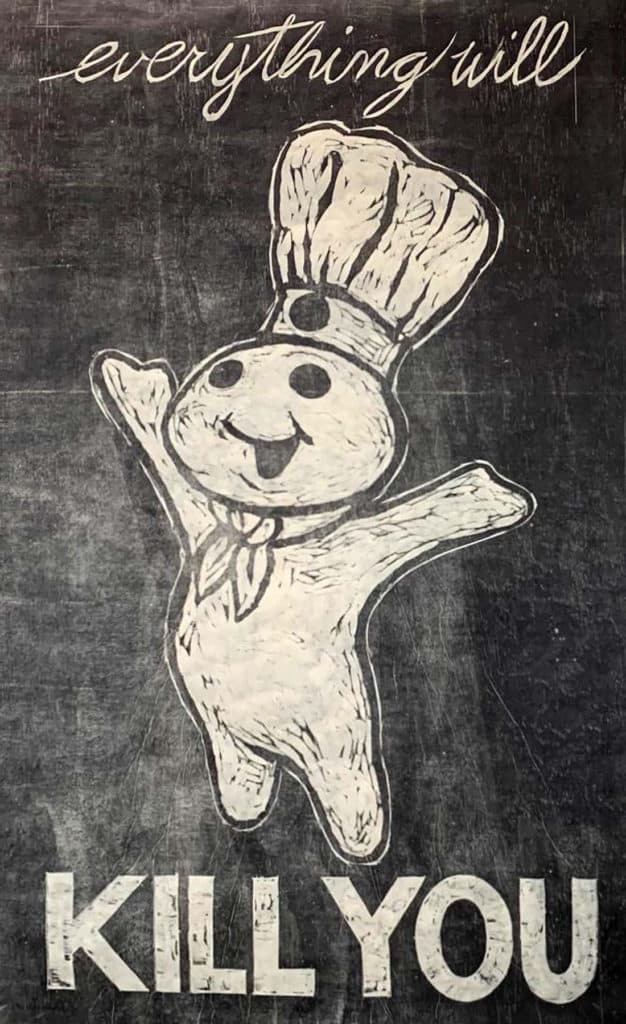“Pushing Pop,” a current exhibition by eight artists at the Artists Collective | Spartanburg, responds to the changes within popular culture since the original “pop art” movement of the early 1960s. The exhibition is in the Solomon Gallery at ACS through Feb. 25.
“The first time the term ‘pop art’ was officially used was in 1962, when A Symposium on the Pop Art was held by the Museum of Modern Art,” says artist Steve Garner. “The art of popular culture, also known then as popular realism, new realism, neo-Dadaism and factualism, placed meaning and value on products of mass culture and contemporary life, creating a dichotomy between high- and low-brow aesthetics. Today, art is certainly more integrated into popular culture through modes of communication, thus the lines between high- and low-brow are considerably more blurred.”

Garner continues, “In ‘Pushing Pop,’ themes of mass production, consumption and values are investigated across multiple media by a group of artists who vary in age, experience and background. The varying degrees of personal experiences of the artists with the original movement present a multifaceted commentary on our present-day culture.
“The work in this exhibit serves to mirror our cultural progression through the changes we’ve undergone as technology transforms the objects and images we use in our everyday lives,” he says. “‘Pushing Pop’ revisits this historic art movement, embracing fresh ideas for our time resulting in an inspiring exhibit that will provide a valuable memory for all those that view it.”

Artists participating in the exhibition are Adam Burgess, Steve Garner, Andy Adams (who signs his work) A-N-D, Kent Ambler, Peggy Tanner Day, Ryan Roth, Kym Day and Carey Morton.
The impetus for the exhibit came from Burgess, a visual artist who lives in Taylors, and his teaching mentor and fellow artist Garner, who also is participating in the exhibit.
“We put together the idea of a traveling exhibit now titled ‘Pushing Pop,’” Burgess says. “Joining with several other Upstate artists of different experiences, ages and genders, the group grew legs and went from an idea to reality. Now in its third gallery show, “Pushing Pop” morphs just as my own work continues to morph.
“I am pushing myself to create work that is ‘pop’ to show an evolution from the work done by pop artists from the past,” continues Burgess, who received a master of art teaching from Lander University and a BFA in studio art with a focus on ceramic sculpture from Clemson University. “I want to express and address current political issues and cultural concerns as well as everyday imagery that we may take for granted, without repeating the works done before me.
“I don’t hide my technique,” he says. “I emphasize the use of grids in my work. I try to capture a sense of emotion in my subjects, while using colors as value. The brilliance of the colors in my work is very important to me and my style. As I move forward, my techniques continuously evolve as my subject matter and themes change.”
For nearly a decade in Greenville County, Burgess has been lead teacher for high school visual arts and coaches boys volleyball, while he continues to paint out of his home studio. Garner, who was an art educator for over 30 years on both the college and secondary levels, retired to the art studio in 2013 and is an active member of the Pendleton Square Artist COOP, where he is the gallery director. He attended the University of North Dakota, earning a bachelor of arts degree, master of arts degree in art education and the MFA in studio arts.
Today, some 40 years later, he says his use of media is often mixed, depending on the project. “I’m always running an experiment, trying something I haven’t done before. My philosophy is that art should be fun to do, enjoyable to look at and have a life of its own.” Adams, a native South Carolinian, is a graduate of Anderson University’s South Carolina School of the Arts, receiving a bachelor’s degree in fine arts. “There I took up all forms of art, but found I had an innate feel for painting and conceptual art. In my work I take a conceptual approach. While I want it to be aesthetic, I believe the concept should be key.
“I have an obsession/fascination with words and their impact on people, life and the world,” they continue. “I’ve experimented with breaking down words into letters and explored the way that letters are harmless until people begin moving and placing them to make a word. I use letters in my work, and the viewers have a natural desire to make words out of the letters. By doing this, the work becomes interactive and personal to each viewer. The viewers essentially become a part of the work. Each piece also has a concept specific to the work.
Peggy Tanner Day, a native of Dallas, Texas, is a self-taught artist who lives in Greenville. “As a child, I was drawn to classical figurative realism, especially portraiture. I learned by studying the paint colors and brushwork in famous paintings in museums such as the Meadows Museum of Art in Dallas and the Amon G. Carter Museum of Art in Fort Worth, both of which were near my home.”
Day began painting as an adult in 1993. While living in Atlanta, she painted numerous large residential murals and ceilings, using her favorite Trompe L’oeil techniques. Over the years, she continued painting portrait and landscape commissions in oil, acrylic and pastel from home while raising her daughters, both of whom are talented artists as well. Now that her children are grown, she works from her home-studio in Greenville.
Ryan Roth says, “As an artist, I am interested in exploring the theme of careerism and its impact on society. Through my flower paintings, I aim to illustrate the ways in which people are often consumed by their careers, sacrificing their personal lives and well-being in pursuit of success and achievement.
“My paintings depict a variety of flowers from Dutch flower paintings to more contemporary floral designs, each with its own unique beauty and fragility,” he continues. “Overall, I use flowers as a metaphor for the short-lived nature of success and the pursuit of professional advancement. My flower paintings are intended to serve as a reminder of the importance of balance and self-care in our lives and to encourage viewers to consider the ways in which the pursuit of career success can sometimes come at the expense of our well-being and happiness. By incorporating these themes into my paintings, I hope to create a sense of beauty and vitality, while also prompting viewers to reflect on the deeper meaning and significance of their own lives and careers.”
Roth, who teaches at the Fine Arts Center in Greenville, earned his BFA from Valdosta State University and his MFA in drawing and painting at the University of Georgia.
Kent Ambler, a printmaker and painter living in Greenville, graduated from Ball State University with a bachelor of fine arts degree in painting. He has been a fulltime painter since 1997.

“I have various directions with my work,” Ambler says. “This particular series of woodcuts began about 15 years ago. I made a couple of pieces for this series each year. Some are based on scare tactic ‘news’ stories; some on popular culture.”
Kym Day is a realist oil painter from McKinney, Texas, who was raised in Georgia and the Carolinas. She received a BFA in painting from the Maryland Institute College of Art and an MFA in sculpture from Clemson University. Recently, she has taught at Clemson and Lander universities and has completed artist residencies at 701 CCA in Columbia and at the Bascom Center for Visual Arts in Highlands, North Carolina. She currently works in her home studio in Greenville and exhibits her paintings nationally.
“My paintings filter the nostalgia for my Texan roots through the lenses of pop culture, daydream and fantasy,” Day says. “I find utter joy in merging beauty with absurdity. My painting techniques and use of realism reflect my interest in art historical symbolism. The cowboys and livestock pictured in the work often find themselves subject to dream logic, navigating diversions like takeout food, wildfires and magic eight balls. These operate as metaphors for the junk we consume and create, and our vain desire to see into the future.”
Carey Morton says, “My series explores the interconnectivity of seemingly opposing forces. Crutches, medical equipment and broken machinery are crafted to the likeness of firearms and weaponry. The political undertones of such forms viewed through the lens of our current cultural discourse are unavoidable. On an initial, surface level viewing the pieces speak to issues of violence and gun control, though this is not the final focus. Dissecting the work at a deeper, more nuanced level reveals an interesting dichotomy around cause-and-effect relationships. From the FDA and Big-Pharma, to drugs and regulated systematic education, to the simple binaries of life and death, there exist cycles and systems at play. Some unavoidable, some we ignore, others we choose to rely on; a crutch for society.
“My work deals with the attributes of human dependence and symbiosis with nature, visceral instinct and how cultural experience influences the mind,” Morton says. “Using found objects as icons for our culturally accepted meaning and inherent attributes they represent, I physically alter, rebuild and reinterpret their form and meaning. These sculptures call into question the viewer’s personal interpretation attached to the objects and materials within the work.
The 50 pieces of artwork in the “Pushing Pop” exhibition are offered for purchase.

